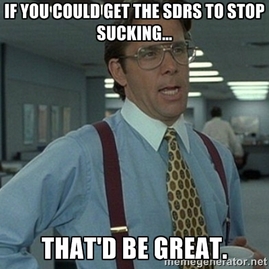Marketers, here’s my guide to improving your relationship with your SDR team:
- Recognize that sales development is the worst job in marketing and sales. I am not saying the Sales Development function isn’t valuable - in fact its invaluable - but SDRs are in a near impossible position. Why?
- SDRs are stuck between marketing and sales, so when pipeline issues arise it is too easy for marketing and sales to point the finger at the guy in the middle.
- The average SDR is green. They are hired right out of school or with 1-2 years of previous experience and usually only stay an SDR for 1-2 years. Even with good training programs, the average SDR (23 years old with 1-2 years of total sales experience) is too green to master sales skills like articulating value, adaptive messaging, objection handling, and goal setting. Of course a VP of sales with a 20 year sales career is going to think they stink on the phone! He’s not wrong, but he is being unreasonable by holding them to too high of a standard.
- SDR managers are in a perpetual state of Groundhog Day. Because of the short lifecycle and high turnover of SDRs, SDR managers’ lives take a predictable pattern: hire, train, get resource somewhat proficient, then immediately lose resource into a junior account executive role. If an SDR manager is able to get SDRs to profient more quickly, she will have them poached away more quickly too. It’s pretty hard to get ahead in that type of scenario.
- How a SDR actually spends their time is never inline with the perception of how they should be spending their time. How often have you seen this: a marketing or sales exec steps on to the SDR floor and says “Why is it so quiet in here?! You all should be on the phones!” What they fail to understand is that SDRs do a lot more than calling. When a hot new inbound lead hits their call queue, they can’t call it right away. They need to do a dozen things before and then another dozen things after the call:
- Check CRM for duplicates
- Check if another SDR has spoken to that company in the last 30 days
- Check if there is an open opp for that company
- Check if they are a target account
- Check the person’s LinkedIn profile
- Look at the company’s website
- Check if the prospect uses a competitor
- Check if they use a complimentary product or service
- Updates 9 different CRM fields with detailed notes
- Send a follow up email
- Schedule a follow up meeting
- etc…
- Set necessary conditions for the marketing/SDR relationship. Your sales development manager will probably assume that its marketing job to provide them with quality leads, but don’t let entitlement creep into the relationship. Make it clear that:
- Marketing spends a lot of the company’s money to generate leads. When leads aren’t followed up on in an appropriate and timely manner company money is wasted.
- If SDRs believe lead quality is below where it should be, you expect to hear about it immediately so you can address it immediately.
- You will help with sales enablement, but only so much. For example, you can help craft training materials and templates, but you have a lot of programs to run too. SDR training can’t be solely marketing’s job.
- Define the vocabulary you will use to speak to one another. For example, define what a Marketing Qualified Lead should be, goals of the qualification process and create a prospect profile together. You will find a common language is critical to efficiency and solving issues as they arise.
- Understand that unless the SDR team rolls up to marketing, managing them is not your job. Even if there are legitimate issues with how an SDR team is operating, solving their issues shouldn’t be your number one priority. The best way a marketer can help a underperforming SDR team is by delivering more, higher quality leads. Prioritize that above all else.
- Sit with the SDR team for at least an hour or two a week. The next time you have 30 minutes to answer email, squat at an open desk on the SDR floor. You can listen to calls, get a sense for how they are spending their time off the phones, and answer questions that come up. You will become more in touch with the sales development team, and also get a much better understanding of your pipeline, programs and prospects.
- Be active in helping craft call scripts, objection handling, and email templates. Marketers are good at creating content.
- Understand the power of public praise to a sales person. Sales is filled with extroverts who thrive on public recognition. A nice job email to an SDR will not have near the impact as public praise in the next team meeting.
- Stop scheduling meetings with SDRs during prime calling hours or at the end of the month. It’s inconsiderate and unprofessional.
- Take low lead flow issues seriously. When an SDR team complains about low lead flow this quarter, if left unresolved, you can bet there is a good chance your VP of sales is going to miss their number next quarter. Get in front of that fiasco by nipping the problem in the bud.
- Discuss SDR territory setting strategy with the SDR manager. While it may seem intrusive to ask to discuss this, marketers have unique perspective on marketing coverage of geographic regions, products, and verticals. This insight can help an SDR manager use territories to set up their people for success rather than failure. For marketers, investing time in this up front will solve future headaches by preventing last minute scrambling to launch territory specific programs when lead flow is uneven across poorly drawn SDR territories.
Maybe I am an SDR apologist, but I love those little guys and gals! Hopefully, you can use some of the ideas above to improve your relationship with your sales development team and make it easier for both parties to crush their numbers.



 RSS Feed
RSS Feed